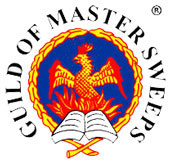Chimney Flue Maintenance
All flues should be checked for blockages caused by falling soot, bird’s nests or masonry debris. Often, these faults will only be revealed by having the chimney swept by a professional chimney sweep who knows exactly what it is they are looking for. A chimney sweep should be carried out regularly once a year.
It is a common misconception that you only need your chimney swept and maintained if you have an open wood burning or coal fireplace. Stoves are all the rage nowadays, and though they might be less of a sooty affair, all stoves and heating appliances that make use of a chimney need to have their flue maintained to safe standards. If you do not ensure that this is done, you are leaving yourself open to:-
* Higher levels of carbon monoxide – This is dangerous for your health even at fairly low, consistent levels. Carbon monoxide poisoning can be a slow process that worsens over time, and is not always the dramatic and sudden reaction to over exposure that most people associate it with. Symptoms can be dangerously subtle and flu-like (e.g fatigue, nausea and feeling generally run-down).
* Higher risk of fires – If your chimney is poorly maintained, the build-up of debris, soot etc will only increase your likelihood of experiencing a fire in your home or in the chimney’s flue itself. Either type of fire is just as dangerous, and if you expect that you have either kind in your house, evacuate the area immediately and dial 999.
Acids or tars generated by wood or coal products are corrosive and can, in time, erode mortar or flaunching. This is an example of the structural damage I mentioned earlier. Any damage caused by the erosion of mortar or flaunching can be found by having it surveyed, as can other signs of damage or holes, which should be repaired promptly to prevent leakage of combustion gases into rooms or roof spaces. Factors such as these are just some of the reasons why most home insurance companies require that you have proof that your chimney is regularly swept in the form of an official certificate, backed by a chimney sweep association.
It is essential that an efficient hearth has a good air supply. As many of us learnt in our school days, a fire needs access to plenty of oxygen to burn well. The fitting of solid fuel or multi fuel stoves should be carried out by a qualified fitter who will ensure that there is adequate ventilation. Sadly, though, this isn’t always the case. Additional venting may sometimes have to be fitted to rectify errors made in your stove’s installation.
A handy tip on how to keep your flue healthy yourself, in between chimney sweeps, is that you should use the proper fuel required for your heating appliance. For wood burning or multi fuel equipment, you should burn only seasoned hardwood. Seasoned hardwood should have a maximum of a 20% moisture content, and it should have been dried for at least one year. Improperly seasoned wood will not burn anywhere near as well, and so can lead to excessive build ups of debris, and is a waste of your hard earned money.
One way of telling if the wood you are buying is properly seasoned is by visually inspecting it. The wood should look dry and cracked, and the inside should be very light in colour, while the drying process should leave the outside of the wood very dark.
By looking after the upkeep of your chimney and stove/fireplace, you will be avoiding a lot of time and effort spent in fixing the problems that builds up and causes faults.


